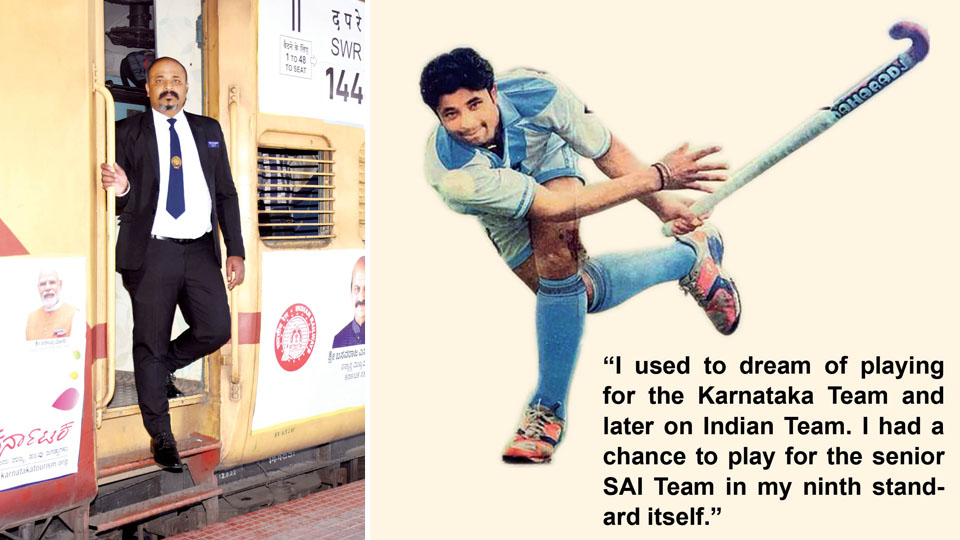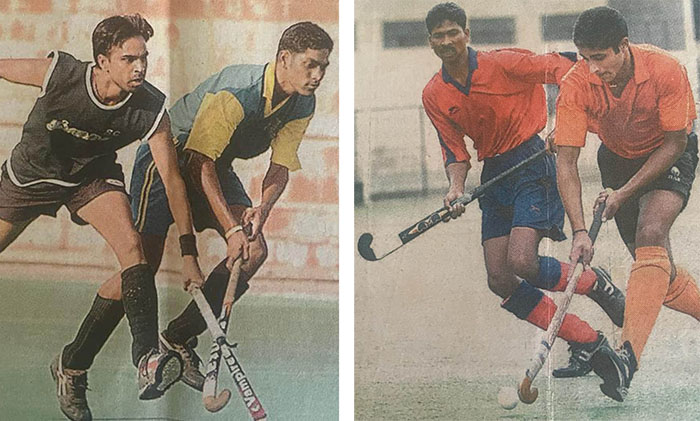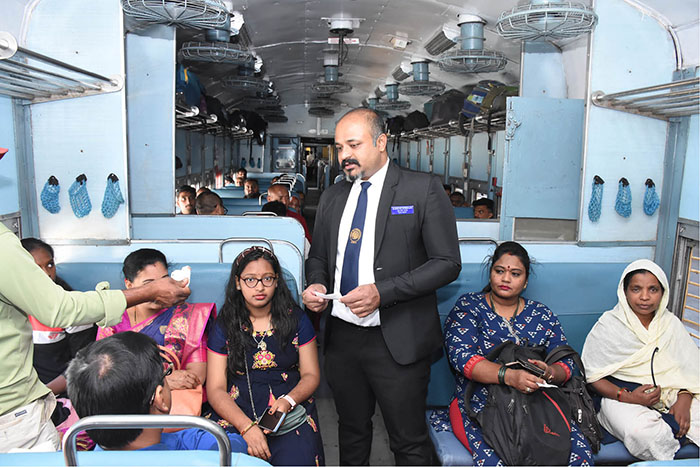
All of 37, Mayur Subbaiah, once a part of India’s medal-winning hockey team, now takes pride in working for the South Western Railways as Deputy Chief Inspector. He was a vital cog in Indian hockey as a drag specialist and an expert in penalty corner conversion.
Mayur might not have been born under a lucky star as the most sought-after Indian hockey player, but he has made his mark in the Indian Hockey arena and his love for the game and sense of duty keeps him going. He continues his passion for the game and does not miss a chance to wield the hockey stick and wants to do something worthwhile for his home district of Kodagu, the cradle of hockey.
Born to Bollajira Jaya Subbaiah and Rathi Subbaiah at Balaji village in South Kodagu on 18.7.1986, Mayur did his primary at Lions School, Gonikoppal from 1990 to 1995 and later went to Bangalore to join Junior Sports Authority of India (SAI) Training Centre in 1996 for hockey selection and he was the youngest and talented player.
He did his schooling at St. Joseph’s Indian High School from Seventh to Tenth Standard and played for several School, District, State and National-level School games. His position in the game was right half and back. Coach Manohar Katige recognised Mayur’s talent and game skills and motivated him. “I hold him in great respect and fondly recall the memories of Manohar Sir who groomed me,” Mayur reveals.
Making the mark very young
“I used to dream of playing for the Karnataka Team and later on Indian Team. I was the youngest player in the school team and many seniors and my coach encouraged me and I had a chance to play for the senior SAI Team in my ninth standard itself. I worked hard and got selected for senior SAI team in 2000 and was a regular player for that team,” he says.
“I saw many senior players on the SAI campus and my inspiration was Anjaparavanda B. Subbaiah, the former Indian hockey goalkeeper and coach. His passion, confidence and positive attitude further motivated me and I had a deep desire of wearing the Indian jersey. At SAI, I saw many Indian top players play like Dhanraj Pillai, Ashish Ballal, Sabu Varkey, Prabhjot Singh and Baljit Singh in action and that was inspirational,” he recalls.
Mayur has played for several Sub-Junior Karnataka, Junior Karnataka and Senior Karnataka hockey teams and he was a specialist in drag-flick. He has played multiple nationals in all categories Under-16, Under-19 and Senior National. He was a part of the Sub-Junior India team in Singapore in 1999 and emerged winners, played for Junior Indian Hockey Team Under-21 match in Dhaka in 2004 and was in the World Cup Under-21 in Chennai.

Lost out due to political lobbying
Though he had a vast experience in playing, Mayur could not play much for India due to political lobbying. “I was best in the ground and was the best in drag-flick and dribbling and no one could match my skills. Still, the selectors preferred some other players over me and this demotivated me. But I managed to make my mark in Indian hockey, despite the politics played by the selectors to include their family members in the national team. If I had support then at my peak, I would have been an ex-Olympian now,” Mayur says with a wry smile.
Mayur was upgraded to the senior SAI camp at the young age of 17. “Len Aiyappa taught me the drag-flick (penalty corner conversion). It involves a player crouching down low next to the ball. It is then picked up by the shaft of the hockey stick and pushed along the ground, while the stick acts like a sling. This helps accelerate the ball. These penalty corners are always taken by a specialist player, known as the drag-flicker. I am proud to say that drag-flick always falls upon the shoulders of someone who is proficient,” Mayur says with confidence.
Camp with commandos
A memorable experience was his time in the National Security Guard (NSG) 45-day Army fitness camp in Manesar with senior Indian hockey team probables where Mayur had the opportunity to play with Dhanraj Pillay, Jugraj, Dilip Tirkey, Ignace Tirkey and many more senior players. This was to make the players mentally tough and increase their endurance levels. “I got an A-1 certificate at the camp,” he adds.
“Being at Senior SAI, I was even playing for the Air India team, Bombay. Bombay was part of the Air India team and I got a job at South Central Railway (Secunderabad) when I was just 18 years and two months. I got through in talent quota and was directly appointed by the Railway Board, New Delhi in 2005 and was the youngest sportsperson of Railway Sports Promotion Board,” he recalls.

Contribution in the Railways teams
As the youngest employee in the Railways, playing for South Central Railway, he gained more experience and laurels and entered the Indian Railways Hockey Teams. Mayur played in All-India tournaments and Senior National Hockey tournaments to win several medals.
“I got the Best Player of the Year Award from the Railway Board. In 2007, I got a call from the Indian Hockey Federation for the Indian National Camp for Olympic Qualifiers Camp and Asia Cup. I got selected for the Asia Cup held in Chennai in 2007 and continued my hockey journey in the Indian Railways and South Central Railway. After playing many All-India tournaments and winning several medals, I got transferred from South Central Railway to South Western Railways,” he says.
“The South Western Railways is the nearest station to my native Kodagu. From 2012 to 2019, I played for this Division and had a successful hockey career for over 22 years. I am now concentrating on my duty as Deputy Chief Inspector. I have received many awards like the DRM Award, PCCM Award and even the GM Award. The motivation provided by the Railway administration helps me keep my dreams alive and every day is a learning experience. Whatever I am today is because of the Indian Railways,” he says.
On future plans, Mayur wants to give back to society. “I want to extend a helping hand to my village, my town, my land and my community which have brought me so much name and fame,” he signs off.
Words of praise from the mentor
“We have had drag-flickers in the team but they are not well-versed in other areas, but Mayur Subbaiah is exceptional. He has the uncanny ability to play in all areas, under any circumstance. If he is provided with a chance in the senior team, he will definitely make a world of difference. I coached Mayur when he was representing SAI and he does not lack in any area because he has got strong basics coming from SAI. His dedication to learning more in the game is tremendous. He has got the passion, is consistent, aggressive, hard-working and has the game.”
[Two-time Olympian and former Indian Goalkeeper Anjaparavanda B. Subbaiah said this about Mayur Subbaiah to a sports magazine]
source: http://www.starofmysore.com / Star of Mysore / Home> Feature Articles / by B.C. Thimmaiah / February 16th, 2023

